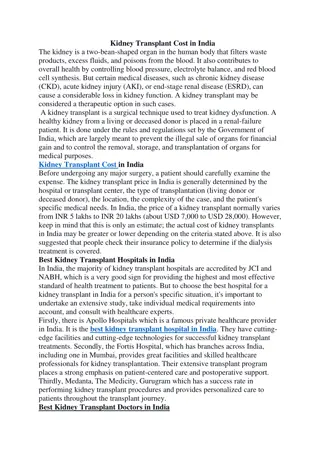Validation of the Edmonton Symptom Assessment System in Kidney Transplant Recipients
Patient-reported outcomes play a crucial role in understanding the symptom burden and quality of life in chronic kidney disease patients, including kidney transplant recipients (KTRs). This study assesses the validity and reliability of the Edmonton Symptom Assessment System in KTRs, focusing on physical and emotional symptom burdens. Conducted at Toronto General Hospital, the research utilized various questionnaires to evaluate symptom distress and quality of life indicators in KTRs older than 18 years. The study highlights the importance of addressing symptoms post kidney transplant to enhance overall well-being.
Download Presentation

Please find below an Image/Link to download the presentation.
The content on the website is provided AS IS for your information and personal use only. It may not be sold, licensed, or shared on other websites without obtaining consent from the author.If you encounter any issues during the download, it is possible that the publisher has removed the file from their server.
You are allowed to download the files provided on this website for personal or commercial use, subject to the condition that they are used lawfully. All files are the property of their respective owners.
The content on the website is provided AS IS for your information and personal use only. It may not be sold, licensed, or shared on other websites without obtaining consent from the author.
E N D
Presentation Transcript
Validation of the Edmonton Symptom Assessment System in kidney transplant recipients Martha Pokarowski1, Sumaya Dano1, Amira Abdalla1, Maroof Khalid1, Oladapo Ekundayo1, Betty Liao1, Nathaniel Edwards and Istvan Mucsi1 1Multi-Organ Transplant Program, University Health Network, Toronto, Canada
Background Patient-reported outcomes provide important information about symptom and illness experience of patients with chronic medical conditions. High symptom burden is frequently experienced by patients with chronic kidney disease (CKD) and it may lead to impaired health-related quality of life (HRQOL). Despite the overall benefits of kidney transplant (KT), including increased life expectancy, KT is not a cure for CKD and many KT recipients (KTR) still experience physical and psychological symptoms that in turn may have an impact on their overall HRQOL.
Background The Edmonton Symptom Assessment System (ESAS) measures physical and emotional symptom burden based on 9 uniquely defined symptoms (pain, tiredness, nausea, lack of appetite, shortness of breath, depression, anxiety, well-being). The ESAS has been developed for patients undergoing cancer- and palliative care. The ESAS-Renal (ESAS-r) has also been validated in patients on dialysis for symptom evaluation. The aim of this study is to assess the validity and reliability of the ESAS-r in KTR.
Study Design A single-centre cross-sectional study was conducted at the Toronto General Hospital from April 2016 and September 2017. A convenience sample of patients was recruited from the the KT outpatient clinics of the University Health Network, Toronto, Canada. Patients included in the study completed the following questionnaires: ESAS-r Kidney Disease Quality of Life Short Form Symptom List (KDQOL-SL) Kidney Disease Quality of Life Short Form-36 Mental Health Component (KDQOL-36 MHC) Patient Health Questionnaire (PHQ-9) Generalized Anxiety Disorder 7-Item Scale (GAD-7) European Quality of Life Questionnaire (EQ-5D-5L)
Population Selection Inclusion Criteria Older than 18 years of age Received a kidney transplant more than 30 days prior to enrolment Able to understand English at a grade 5 level Willing and able to provide consent Exclusion Criteria Severe acute illness or condition Dementia
Methods Individual ESAS symptom scores were combined into a Physical Symptom Distress score (pain, tiredness, drowsiness, nausea, lack of appetite, shortness of breath), Emotional Symptom Distress score (depression, anxiety), and a Global Symptom Distress score that merges all 9 symptoms. Patients completed all questionnaires using a tablet based electronic data capture platform (DADOS, Techna Institute, UHN, Toronto). Information about medical history and laboratory test results was obtained from electronic health records.
Methods Validity Convergent validity assessed using Spearman s rank correlation Known-group comparisons forming potentially clinically different groups using clinical variables [hemoglobin, albumin, estimated glomerular filtration rate (eGFR), Charlson Comorbidiy Index (CCI)] Reliability Internal consistency assessed using Chronbach s alpha
Patient Flow Diagram Eligibile patients approached N = 262 Declined/Missing Information N = 42 Final Cohort N = 220
Baseline characteristics of study sample Table 1. Population Demographics N = 220 Age in years, mean (SD) 50 (17) Gender, n (%) Male 131 (60) Female 89 (40) Ethnicity, n (%) White 130 (59) Black 22 (10) Education Less than high school More than high school Diabetes Mellitus, n (%) Yes No Charlson Commorbidity Index (CCI), n (%) < 3 3-4 > 4 Glomerular filtration rate (eGFR), mean (SD) Albumin g/L, mean (SD) 153 (70) Hemoglobin g/L, mean (SD) 65 (31) 148 (69) 54 (25) 166 (75) Asian Other 43 (20) 25 (11) 97 (51) 61 (32) 33 (17) 57 (23) Time since transplant, n (%) <1 year 44 (20) 1 3 years >3 years 23 (10) 42 (3) 128 (17)
Table 2. Instrument characteristics Instrument Description Assesses physical and emotional symptom distress Individual scores ranging from 0 (no symptom distress) to 10 (severe symptom distress) ESAS-r Assesses physical and emotional symptom distress Total score ranges from 0 (high symptom distress) to 100 (no symptom distress) KDQOL-SF SL Assess the mental health state of patients with CKD Total score ranges from 0 (lowest level of mental health) to 100 (highest level of mental health) KDQOL-36 MHC Diagnostic tool for Generalized Anxiety Disorder Total score ranges from 0-27; a higher score is indicative of higher anxiety PHQ-9 Detects the presence and severity of depressive symptoms Total score ranges from 0-27; a higher score is indicative of increased depressive state GAD-7 Measures patient health status through examining mobility, self-care, usual activities, pain and discomfort, anxiety and depression Total score ranges from 0 (poor health state) to 1 (highest health state attainable) EQ-5D-5L
Table 3. Internal Consistency and Distribution of Scores ESAS-r symptom/ domain Physical Symptom Distress Cronbach s Alpha ( ) ESAS-R Legacy instrument Legacy Mean(min,max) Mean(min,max) 7.87 (0, 42) 0.81 Pain Tiredness Drowsiness Nausea Lack of Appetite Shortness of Breath Emotional Symptom Distress 2.56 (0, 10) 2.62 (0, 9) 1.65 (0, 9) 0.41 (0, 8) - - - - KDQOL-SF SL 85.56 (30, 100) 0.81 (0, 10) - 0.95 (0, 8) - 2.19 (0, 18) 0.83 KDQOL-36 MHC 50.71 (18, 63) Depression Anxiety Well-being Global Symptom Distress 1.03 (0, 10) 1.16 (0, 10) 2.16 (0, 10) - - - PHQ-9 GAD-7 - 3.53 (0, 23) 2.67 (0. 21) - 11.87 (0, 58) 0.86 EQ-5D-5L 0.84 (0.24, 0.95) = 0.80-0.89: good internal consistency; > 0.90: excellent internal consistency
Rho = -0.62 (-0.70, -0.53) |Rho| > 0.8: Very strong correlation, 0.6-0.8: Strong correlation
Rho: -0.58 (-0.67, -0.49) |Rho| > 0.8: Very strong correlation, 0.6-0.8: Strong correlation
Rho: 0.65 (0.55, 0.72) |Rho| > 0.8: Very strong correlation, 0.6-0.8: Strong correlation
Rho: 0.60 (0.48, 0.69) |Rho| > 0.8: Very strong correlation, 0.6-0.8: Strong correlation
Rho: -0.71 (-0.78, -0.61) |Rho| > 0.8: Very strong correlation, 0.6-0.8: Strong correlation
Table 4. Known-group comparisons of the ESAS global distress score. N ESAS Global Median (IQR) ESAS Global Median (IQR) P Albumin (g/L) Low (<39) High (>44) Hemoglobin (g/L) Low (<119) High (>134) eGFR (mL/min/m2) Low (<43) High (>67) CCI Low (<2) High (>4) 31 63 37 (35-38) 45 (44-46) 12.5 (4-21) 8 (2-18) 0.17 70 63 112 (104-118) 145 (141-152) 13 (4-23) 5 (0-19) 0.016 66 66 35 (26-39) 80 (73.5-95.5) 11.5 (4-20) 6.5 (2-12) 0.038 92 58 1 (0-1) 4 (4-5) 6 (1-15.5) 10.5 (2-18) 0.13
Discussion Internal consistency scores demonstrated good reliability when ESAS-r symptoms were grouped into physical, emotional, and global symptom scores. ESAS-r symptoms correlated well with legacy questionnaires. The ESAS Global Symptom Distress score significantly differs between low and high albumin and eGFR levels, whereas a moderate trend in observed for high and low levels of both hemoglobin and CCI. Greater emotional symptom scores using KDQOL-36 MHC, GAD-7 or PHQ-9 compared to ESAS-r for the same patients may infer that patients are more likely to endorse a multidemensional assessment of anxiety/depressive symptoms as opposed to providing a rating of their depression of anxiety , which are stigmatized and loaded words.
Conclusion Introducing the ESAS-r as part of routine clinical care for KTRs may enhance communication between patients and their providers regarding their symptom severity or intensity Due to floor effects and incongruencies in emotional system scores compared to legacy questionnaires, more work is required to determine the screening ability of the ESAS-r. Disclosures: There are no conflicts of interest relevant to this poster presentation























